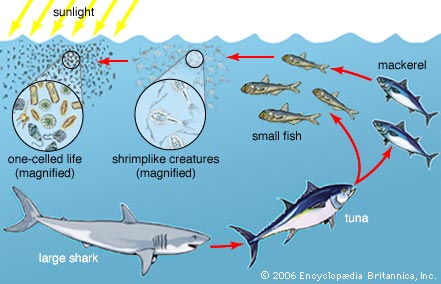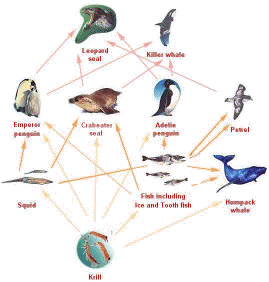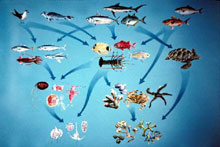Source (google.com.pk)
Tiger Shark Food Web Biography
1. Introduce the simulation activity.
Ask students to imagine that they are animals in Australia’s Shark Bay ecosystem. Explain that you will assign each student a role, and they will explore what happens when they interact with other animals in the
food web.
2. Assign roles.
Give each student a slip of paper that assigns him or her the role of one of the following animals in the Shark Bay food web: bottlenose dolphins, dugongs, green sea turtles, and tiger sharks. There should be far fewer tiger sharks than dugongs, sea turtles, and dolphins. For example, if you have a class of 30 students, there should be 4 tiger sharks, 6 dolphins, 10 turtles, and 10 dugongs.
3. Conduct the simulation.
•Designate one section of the room as an area of sea grass. Explain that the sea grass supports many animals and is very important to the ecosystem.
•Ask the dugongs and turtles to go to the sea grass area. Explain that the grass is their favorite type of food. Tell them they cannot leave the sea grass area.
•Ask the dolphins to stand in an area near the sea grass. Explain that they might be looking for fish to eat.
•Have the tiger sharks travel slowly to the area where the dolphins, turtles, and dugongs are. Explain that the sharks are hungry—what will they decide to eat today? Allow each shark to choose “prey” by selecting one of the other students to “eat” and tapping the student on the shoulder. The students “eaten” by the sharks should go to another area of the room to watch the rest of the simulation.
•Pause the simulation and tell the dolphins that they are scared of sharks. Tell the dolphins to take three steps away from the sea grass when a shark gets close to them.
•Each shark, meanwhile, should return to the sea grass and “eat” another turtle or dugong.
4. Have students reflect on their experiences and new understandings.
Ask students to describe what they learned from the simulation. Ask: What would be different if there were no sharks? Students should recognize that the sharks changed the behavior of the dolphins. They should also realize that the sharks, by eating sea turtles and dugongs, help keep those animals from eating too much sea grass. Ask: What might happen if the animals eat too much of the sea grass? Students should understand that if the sea grass disappears, so will many of the animals that eat it, including green sea turtles, dugongs, and possibly tiger sharks. Make sure students understand that the sea grass is important in the ecosystem, and the tiger sharks help keep the sea grass at just the right level by eating the animals that eat the grass.
Extending the Learning
Conduct more simulations. Increase or decrease the number of sharks and other animals in the food web to see what the outcomes might be.










Tiger Shark Food Web Biography
1. Introduce the simulation activity.
Ask students to imagine that they are animals in Australia’s Shark Bay ecosystem. Explain that you will assign each student a role, and they will explore what happens when they interact with other animals in the
food web.
2. Assign roles.
Give each student a slip of paper that assigns him or her the role of one of the following animals in the Shark Bay food web: bottlenose dolphins, dugongs, green sea turtles, and tiger sharks. There should be far fewer tiger sharks than dugongs, sea turtles, and dolphins. For example, if you have a class of 30 students, there should be 4 tiger sharks, 6 dolphins, 10 turtles, and 10 dugongs.
3. Conduct the simulation.
•Designate one section of the room as an area of sea grass. Explain that the sea grass supports many animals and is very important to the ecosystem.
•Ask the dugongs and turtles to go to the sea grass area. Explain that the grass is their favorite type of food. Tell them they cannot leave the sea grass area.
•Ask the dolphins to stand in an area near the sea grass. Explain that they might be looking for fish to eat.
•Have the tiger sharks travel slowly to the area where the dolphins, turtles, and dugongs are. Explain that the sharks are hungry—what will they decide to eat today? Allow each shark to choose “prey” by selecting one of the other students to “eat” and tapping the student on the shoulder. The students “eaten” by the sharks should go to another area of the room to watch the rest of the simulation.
•Pause the simulation and tell the dolphins that they are scared of sharks. Tell the dolphins to take three steps away from the sea grass when a shark gets close to them.
•Each shark, meanwhile, should return to the sea grass and “eat” another turtle or dugong.
4. Have students reflect on their experiences and new understandings.
Ask students to describe what they learned from the simulation. Ask: What would be different if there were no sharks? Students should recognize that the sharks changed the behavior of the dolphins. They should also realize that the sharks, by eating sea turtles and dugongs, help keep those animals from eating too much sea grass. Ask: What might happen if the animals eat too much of the sea grass? Students should understand that if the sea grass disappears, so will many of the animals that eat it, including green sea turtles, dugongs, and possibly tiger sharks. Make sure students understand that the sea grass is important in the ecosystem, and the tiger sharks help keep the sea grass at just the right level by eating the animals that eat the grass.
Extending the Learning
Conduct more simulations. Increase or decrease the number of sharks and other animals in the food web to see what the outcomes might be.
Tiger Shark Food Web

Tiger Shark Food Web

Tiger Shark Food Web

Tiger Shark Food Web

Tiger Shark Food Web

Tiger Shark Food Web

Tiger Shark Food Web

Tiger Shark Food Web

Tiger Shark Food Web
Tiger Shark Food Web

Tiger Shark Food Web
No comments:
Post a Comment